We’ve all seen that perfect haircut that makes heads turn – the blowout taper. This modern twist on classic barbering combines the sharp precision of a taper fade with the voluminous texture of a blowout style. It’s become the go-to choice for men who want versatility without sacrificing sophistication.
The blowout taper delivers the best of both worlds: professional polish for the boardroom and effortless style for weekend adventures. We’re talking about a cut that works with your natural hair texture while giving you that coveted “just left the barbershop” look every single day.
Whether you’re considering your first blowout taper or looking to perfect your current style, we’ll walk you through everything you need to know. From understanding the technique to maintaining that fresh look, this comprehensive guide covers all the essentials to help you master one of today’s most requested haircuts.
What Is a Blowout Taper and Why It’s Taking Over Men’s Hair Trends
Blowout tapers combine the clean precision of traditional taper cuts with the voluminous styling of professional blowouts. This innovative technique creates a seamless transition from longer hair on top to shorter sides and back while maintaining maximum volume and texture throughout the crown area.
Professional barbers achieve this look by using specialized blow-drying techniques during the cutting process. They strategically direct airflow to lift hair fibers at the roots while simultaneously tapering the length along the sides and neckline. This dual approach results in a haircut that appears naturally full bodied yet professionally groomed.
Men’s grooming trends have shifted dramatically toward styles that offer both sophistication and effortless appeal. The blowout taper perfectly captures this balance by delivering a polished appearance that doesn’t require extensive daily styling. Celebrities like Michael B. Jordan and Timothée Chalamet have popularized similar volume forward cuts on red carpets and social media platforms.
Social media platforms have accelerated the blowout taper’s popularity among younger demographics. Instagram and TikTok showcase thousands of transformation videos featuring this cut, generating millions of views and inspiring men to request similar styles from their barbers. The hashtag #blowouttaper has accumulated over 50 million views across various platforms.
Versatility makes the blowout taper particularly appealing to modern professionals. Morning styling requires minimal effort since the cut naturally maintains its shape and volume when properly executed. Office appropriate versions feature subtle tapering while weekend variations can incorporate more dramatic length contrasts and textured finishes.
Hair texture compatibility spans across multiple hair types and ethnicities. Straight hair benefits from enhanced volume and movement while curly and coily textures gain definition and controlled shape. This universal adaptability has contributed significantly to the style’s widespread adoption across diverse communities.
Choose the Right Blowout Taper Style for Your Face Shape
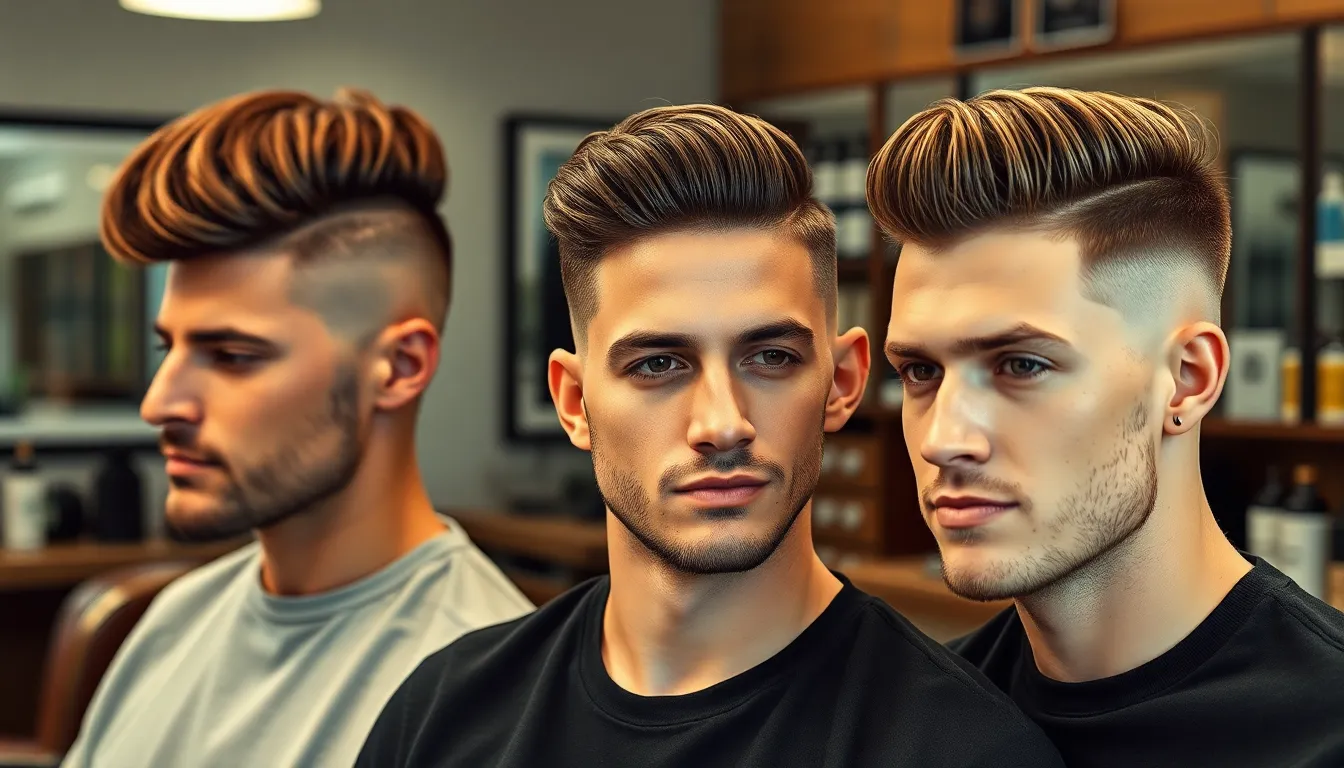
Matching your blowout taper to your face shape maximizes the style’s flattering potential. Different facial structures benefit from exact taper variations that enhance natural features while creating balanced proportions.
Round Face Shape Considerations
Add height and angular definition with a high blowout taper that creates vertical lines along your face. The longer top section should be styled upward and slightly forward to elongate your facial structure. Avoid low tapers that emphasize width, as they can make round faces appear fuller than desired.
Select medium to high fade transitions that start above the ears to draw attention upward. Your barber should maintain substantial length on top while keeping the sides tight and clean. This contrast creates the illusion of a more oval shaped face by reducing perceived width.
Style the crown area with maximum volume using a round brush during blow drying. The lifted roots and forward swept fringe help counteract the circular proportions of round face shapes. Professional stylists recommend keeping the sides trimmed every 2-3 weeks to maintain the elongating effect.
Square Face Shape Options
Soften sharp jawlines with a medium blowout taper that doesn’t create harsh contrasts between the top and sides. The gradual fade should start around the temple area to avoid emphasizing the width of your jaw. Slightly longer hair on the sides prevents the cut from appearing too severe.
Incorporate textured styling on top to break up the geometric lines that can mirror a square face’s natural angles. Your stylist should use texturizing techniques during the blowout process to create movement and flow. This approach reduces the rigid appearance that can occur with overly structured cuts.
Choose side swept styling rather than straight back looks to introduce curves that complement angular features. The blowout should create volume that moves diagonally across the head rather than straight up. Barbers often recommend a slight part to one side for the most flattering results on square face shapes.
Oval Face Shape Versatility
Experiment with any blowout taper variation since oval faces provide the ideal canvas for this versatile cut. Your balanced proportions allow for both high and low fade options without compromising facial harmony. Most professional barbers consider oval shaped faces the easiest to work with for blowout taper styles.
Customize the fade height based on your personal preference and lifestyle needs. Low fades offer a conservative professional look while high fades create more dramatic contrast for casual settings. The natural balance of oval faces means you can switch between different taper intensities without negative effects.
Adjust the top length anywhere from 2 to 6 inches depending on your desired styling options. Shorter lengths provide easier maintenance while longer sections allow for more dramatic blowout effects. Your face shape’s versatility means the focus can be on texture, volume, and personal style preferences rather than corrective styling techniques.
Prepare Your Hair for the Perfect Blowout Taper Cut

Proper preparation sets the foundation for achieving a flawless blowout taper that enhances your natural features. Getting the right cut starts with understanding your hair’s unique characteristics and communicating effectively with your barber.
Hair Length Requirements
Starting with adequate length ensures your barber has enough hair to work with for the blowout styling. We recommend having at least 2-3 inches of hair on top to create the signature volume that defines this cut. Shorter lengths limit the dramatic effect that makes blowout tapers so appealing.
Sides and back areas need sufficient length for smooth fade transitions. Your barber requires approximately 1-2 inches on the sides to create seamless tapering that flows naturally from the longer top section. Hair that’s too short restricts the gradual blending that characterizes professional blowout taper cuts.
Growing out your hair for 6-8 weeks before your appointment produces optimal results. This timeframe allows previously cut layers to even out and provides your stylist with a clean canvas. Uneven lengths from previous cuts can interfere with the precise layering techniques used in blowout taper styling.
Hair Texture Considerations
Thick hair creates the most dramatic blowout taper results with natural volume and body. Dense hair strands hold the lifted styling better and maintain the cut’s shape longer between salon visits. Your barber can use this thickness to create impressive height and movement in the top section.
Fine hair requires strategic layering techniques to achieve the desired fullness. We’ve found that professional stylists use exact cutting angles and texturizing methods to add visual weight to thinner strands. Volume improving products become essential for maintaining the blowout effect with this hair type.
Curly and wavy textures offer unique advantages for blowout taper cuts. Natural texture provides built in volume that enhances the overall appearance without requiring extensive styling products. Your barber can work with your hair’s natural pattern to create customized results that complement your curl structure.
Straight hair needs additional preparation to hold the blowout styling effectively. Pre cut treatments and exact product applications help create grip and texture that support the lifted appearance. Professional barbers often recommend volumizing shampoos and lightweight mousses for this hair type.
Pre-Cut Consultation Tips
Bringing reference photos helps communicate your vision clearly to your barber. We suggest collecting 3-4 images that showcase different angles of your desired blowout taper style. Social media platforms like Instagram provide excellent examples of various fade heights and styling approaches.
Discussing your daily styling routine ensures realistic expectations for maintenance. Your barber needs to understand how much time you’re willing to spend on morning styling to recommend appropriate fade levels. Busy schedules might benefit from lower maintenance versions of the blowout taper.
Mentioning any previous haircut disappointments prevents repeating unwanted results. Professional stylists appreciate knowing what didn’t work in the past so they can adjust their approach accordingly. This information helps them tailor the cut to your exact preferences and hair behavior.
Asking about styling product recommendations during consultation saves time and money. Your barber can suggest exact brands and formulations that work best with your hair type for the blowout taper look. Professional grade products often provide better results than drugstore alternatives for maintaining this style.
Master the Blowout Taper Cutting Technique Step by Step
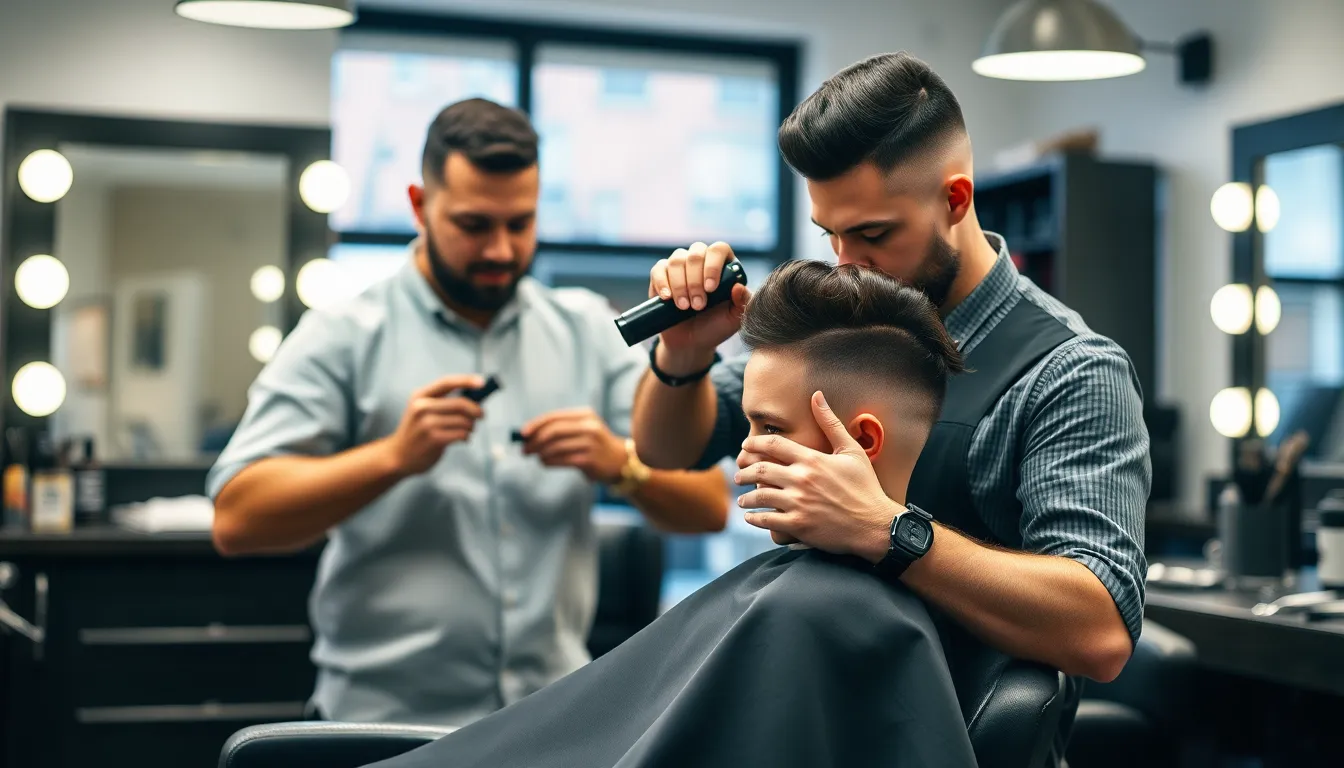
Mastering the blowout taper technique requires precise execution and the right professional approach. We’ll break down each component to help you achieve consistent, salon-quality results.
Essential Tools and Equipment
Professional clippers form the foundation of any successful blowout taper cut. We recommend using adjustable blade clippers like Wahl Magic Clip or Andis Master for their precision and reliability. Quality trimming scissors measuring 5.5 to 6.5 inches provide the necessary control for detailed work around the crown area.
Sectioning combs with fine teeth create clean parting lines during the cutting process. We use carbon fiber combs because they resist heat and static while maintaining their shape throughout multiple cuts. Metal clipper guards ranging from #1 to #4 ensure consistent length transitions across different sections.
Blow dryers with concentrator nozzles direct airflow precisely where needed during the styling phase. Professional models delivering 1800 to 2000 watts provide sufficient power for lifting hair at the roots. Round brushes in multiple sizes accommodate varying hair lengths and desired volume levels.
Texture spray and light-hold styling products enhance the natural movement created by the blowout technique. We keep these within arm’s reach to apply immediately after cutting for optimal results.
Clipper Settings and Guard Numbers
Starting with a #3 guard creates the ideal foundation length for most blowout taper cuts. We begin at the occipital bone and work our way down to establish the initial perimeter. The #2 guard comes next for the mid-taper section, blending seamlessly into the longer top section.
Transitioning to a #1 guard around the ear area requires careful attention to natural hairline patterns. We adjust blade tension to 50% when working with this shorter length to prevent harsh lines. The #0.5 guard or open blade technique works best for the final fade near the neckline.
Lever positions play a crucial role in achieving smooth transitions between guard lengths. Opening the lever halfway creates intermediate lengths that bridge the gap between full guard sizes. We recommend practicing lever control on mannequin heads before working with clients.
Blade angles should remain consistent at approximately 45 degrees when moving upward through the taper. This angle prevents the clipper from digging too deeply into the hair while maintaining proper cutting tension.
Blending and Fading Methods
Overlapping cutting sections by 25% ensures seamless blending between different guard lengths. We start each new section slightly higher than the previous cut line to eliminate visible demarcation lines. The key lies in maintaining steady hand movement while applying consistent pressure.
Flicking motions at the end of each clipper stroke lift hair away from the head naturally. This technique prevents the flat appearance that occurs when clippers are pulled straight down through the hair. We practice this motion in smooth, controlled arcs.
Cross-checking involves cutting perpendicular to the original cutting lines to catch any uneven spots. We use this method particularly around the crown area where natural growth patterns can create irregularities. Point cutting with scissors adds texture and softens any harsh edges left by clipper work.
Blow drying begins immediately after cutting while hair retains its natural moisture. We direct airflow upward through the top section while using tension from a round brush. The sides receive quick bursts of air to enhance the taper’s natural shape and eliminate any compressed areas from clipper work.
Style Your Blowout Taper for Different Occasions

Your blowout taper can adapt to any setting with the right styling approach and product selection. We’ll explore three distinct ways to style your cut for different occasions throughout your week.
Casual Everyday Styling
Sea salt spray creates the perfect foundation for relaxed weekend styling while maintaining your blowout taper’s natural texture. Apply the spray to damp hair and scrunch gently with your fingers to enhance volume without appearing overdone. Air drying works exceptionally well for casual occasions since it preserves the cut’s organic movement and prevents the overly polished look that formal settings require.
Lightweight pomade offers another excellent option for everyday wear when you want slightly more definition than sea salt spray provides. Work a small amount through your hair using upward motions to lift the crown area while keeping the tapered sides clean. The result maintains your blowout taper’s structure while looking effortlessly cool for coffee dates, shopping trips, or hanging out with friends.
Texturizing powder becomes your best friend on second day hair when your blowout taper needs a volume boost. Sprinkle small amounts directly onto your roots and massage gently to restore lift without adding weight or greasiness to your style.
Professional Business Look
Matte paste delivers the sophisticated hold necessary for boardroom presentations while keeping your blowout taper looking polished throughout long workdays. Apply the paste to slightly damp hair and use a fine tooth comb to create clean lines that emphasize the taper’s precision. This combination ensures your hairstyle remains professional without appearing stiff or unnatural during important meetings.
Blow drying technique becomes crucial for achieving that crisp business appearance that commands respect in professional settings. Use a round brush to direct airflow from roots to ends while pulling hair slightly forward to maintain volume at the crown. The controlled styling prevents flyaways and creates the smooth finish that conservative dress codes demand.
Light hairspray provides the finishing touch that keeps your professional blowout taper intact during demanding workdays. Spray from 8 inches away using sweeping motions to avoid creating crunchy spots that might appear unprofessional during client interactions or networking events.
Special Event Styling
Strong hold gel transforms your blowout taper into a statement piece perfect for weddings, galas, or other formal celebrations where you want maximum impact. Work the gel through wet hair and use your fingers to create dramatic height at the crown while maintaining the sharp contrast with your tapered sides. This approach delivers red carpet worthy results that photograph beautifully under event lighting.
Shine serum adds the glossy finish that makes your blowout taper appear camera ready for special occasions where you’ll be photographed frequently. Apply one pump to your palms and smooth over the styled hair to create luminous highlights that catch light beautifully without appearing greasy or overdone.
Professional blow dry service offers the ultimate luxury when preparing for milestone events where your appearance matters most. Skilled stylists can create volume and precision that lasts throughout long celebrations while ensuring your blowout taper looks flawless from every angle during photos and social interactions.
Maintain Your Blowout Taper Between Salon Visits

Keeping your blowout taper looking fresh requires consistent care and smart styling choices. We’ll show you how to extend your haircut’s lifespan with proper maintenance techniques.
Daily Styling Routine
Start with damp hair for the best blowout taper results. We recommend towel drying your hair to about 70% dryness before applying any products. Apply a lightweight volumizing mousse from mid-length to roots, focusing on areas where you want maximum lift.
Use a round brush while blow drying to recreate the salon finish. Pull hair upward and outward from the scalp using a 2-inch barrel brush for optimal volume. Direct the airflow from your blow dryer down the hair shaft to smooth the cuticle and reduce frizz.
Work in sections starting from the back and moving forward. Divide your hair into 4-6 manageable sections using clips to ensure even heat distribution. Spend 15-20 seconds on each section with medium heat to avoid damage while achieving the desired shape.
Finish with cool air to set your style in place. Switch your blow dryer to the cool setting for the final 30 seconds of styling. This technique locks in volume and extends your blowout taper’s hold throughout the day.
Apply finishing products sparingly to maintain natural movement. We suggest using a pea-sized amount of lightweight pomade or texturizing spray on the top section only. Avoid applying product to the tapered sides to preserve their clean appearance.
Weekly Hair Care Tips
Wash your hair 2-3 times per week to maintain scalp health without over-stripping natural oils. Frequent washing can cause your blowout taper to lose volume and texture more quickly. Use lukewarm water to prevent your hair from becoming overly dry or frizzy.
Deep condition weekly to keep your hair healthy and manageable. Apply a protein-rich hair mask to damp hair from mid-length to ends, avoiding the scalp area. Leave the treatment on for 10-15 minutes before rinsing thoroughly with cool water.
Sleep on silk or satin pillowcases to reduce friction and maintain your style overnight. These materials cause less hair breakage and help preserve the volume in your blowout taper. We also recommend loosely tying longer sections with a silk scrunchie to prevent tangling.
Avoid excessive heat styling between salon visits to prevent damage. Limit flat iron or curling iron use to special occasions only. When heat styling is necessary, always apply a thermal protectant product and use the lowest effective temperature setting.
Brush gently using a wide-tooth comb or boar bristle brush to detangle without disrupting your style. Start from the ends and work your way up to the roots to minimize breakage. Brush only when hair is damp or completely dry, never when wet and vulnerable.
Touch-Up Scheduling
Book your next appointment 3-4 weeks ahead to maintain the perfect blowout taper shape. The tapered sides grow out faster than the top section, creating an unbalanced appearance after this timeframe. Schedule during your current visit to secure your preferred barber and time slot.
Watch for these signs that indicate you need a touch-up: sides appearing puffy, fade lines becoming visible, or difficulty achieving volume during styling. Hair growth patterns vary, but most clients notice these changes around the 3-week mark.
Consider mini appointments between full cuts for maintenance touch-ups. Many salons offer 15-minute services to clean up the sides and back only. These quick sessions cost 30-40% less than full cuts and keep your blowout taper looking sharp.
Plan around important events by scheduling cuts 3-5 days before special occasions. Fresh cuts often look too perfect immediately after styling, so this timing allows your hair to settle naturally. We recommend avoiding cuts the day before major events like weddings or job interviews.
Track your growth patterns by taking weekly photos of your blowout taper from different angles. This documentation helps you identify the optimal timing for future appointments. Most clients develop a consistent 3-4 week cycle once they establish their preferred maintenance routine.
Avoid Common Blowout Taper Mistakes That Ruin the Look
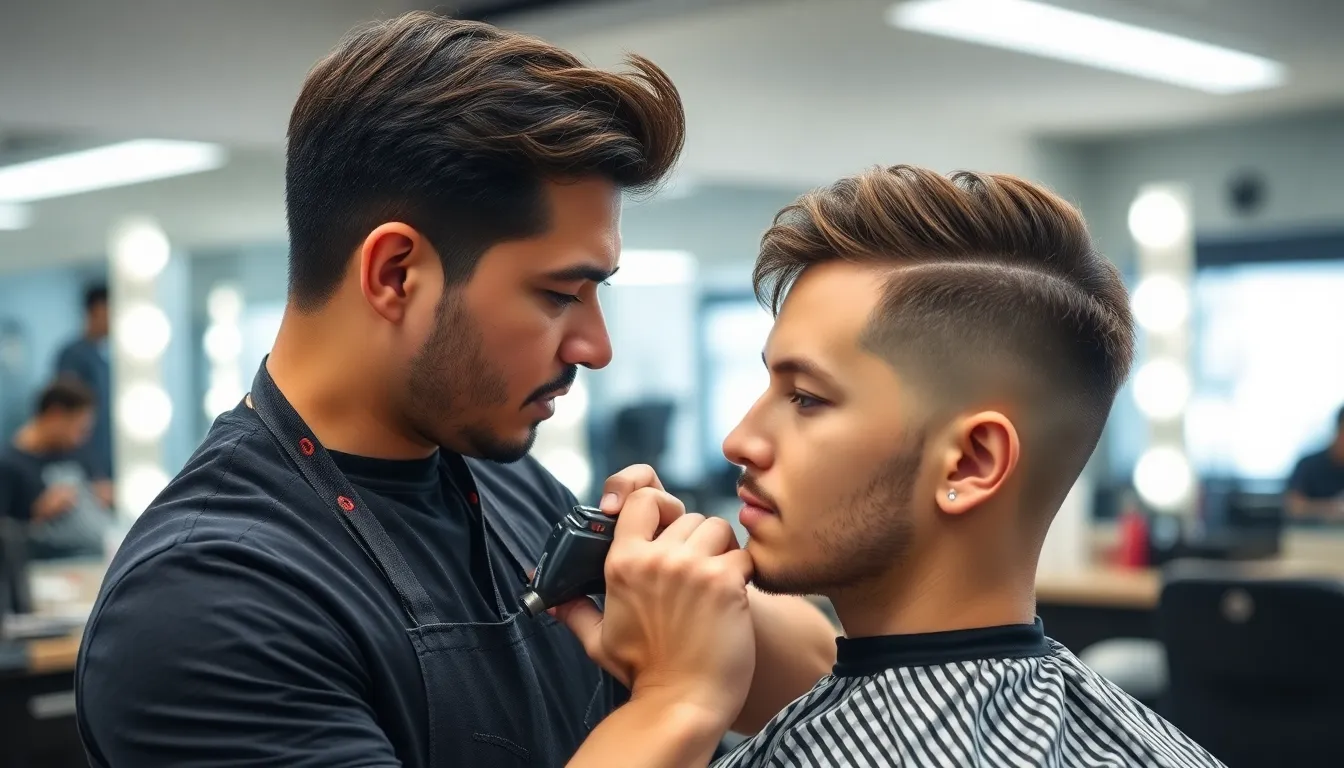
Even experienced barbers occasionally make errors that compromise the blowout taper’s polished appearance. Understanding these pitfalls helps ensure your haircut maintains its sophisticated edge.
Over-Cutting the Fade
Creating too aggressive a fade destroys the blowout taper’s signature gradual transition. Barbers who rush through the tapering process often remove excessive length from the mid-sections, leaving harsh lines instead of smooth blending. Professional stylists recommend using guards no shorter than a #2 for the initial fade, gradually working down to create seamless transitions.
Taking off too much length at once creates irreversible damage to the overall shape. We’ve observed that barbers who skip intermediate guard sizes produce choppy, uneven results that require weeks to grow out properly. The fade should progress gradually from #4 to #3 to #2, with careful attention to blending between each section.
Extending the fade too high up the head eliminates the volume contrast essential to the blowout effect. Proper blowout tapers maintain at least 2-3 inches of full length on top, with the fade beginning no higher than the temple area. Cuts that start fading above the ears lose the dramatic height difference that makes this style distinctive.
Incorrect Product Application
Using too much product weighs down the hair and prevents the signature lift that defines blowout tapers. Heavy creams or gels applied liberally throughout the hair create flat, greasy results instead of the desired volume and movement. Professional barbers recommend using no more than a dime-sized amount of volumizing mousse on damp hair.
Applying products to completely wet hair dilutes their effectiveness and prolongs drying time. Hair should be towel dried to about 70% moisture before product application, allowing styling agents to penetrate properly and create lasting hold. Products applied to soaking hair simply slide off without providing structural support.
Skipping heat protectant before blow drying causes long-term damage that makes future styling increasingly difficult. Regular exposure to high heat without protection leads to brittle, frizzy hair that won’t hold the smooth finish characteristic of quality blowout tapers. We always apply thermal protection spray before any heat styling to preserve hair integrity.
Neglecting Hair Health
Failing to maintain scalp health creates an unstable foundation that undermines even expertly cut blowout tapers. Clogged follicles from product buildup or insufficient cleansing prevent hair from growing at optimal angles, disrupting the cut’s intended shape. Regular scalp exfoliation every two weeks removes dead skin and product residue.
Ignoring split ends allows damage to travel up the hair shaft, creating frizzy texture that fights against the blowout’s smooth finish. Trimming damaged ends every 6-8 weeks maintains the hair’s ability to lie flat and respond to styling tools. Split ends make it impossible to achieve the sleek, polished look that distinguishes professional blowout tapers.
Overwashing strips natural oils that provide flexibility and shine essential to the blowout taper’s appeal. Daily shampooing removes protective sebum, leaving hair dry and difficult to style into the desired shape. Limiting washes to every other day or using dry shampoo between washes preserves the hair’s natural conditioning while maintaining cleanliness.
Find the Best Barber for Your Blowout Taper Needs
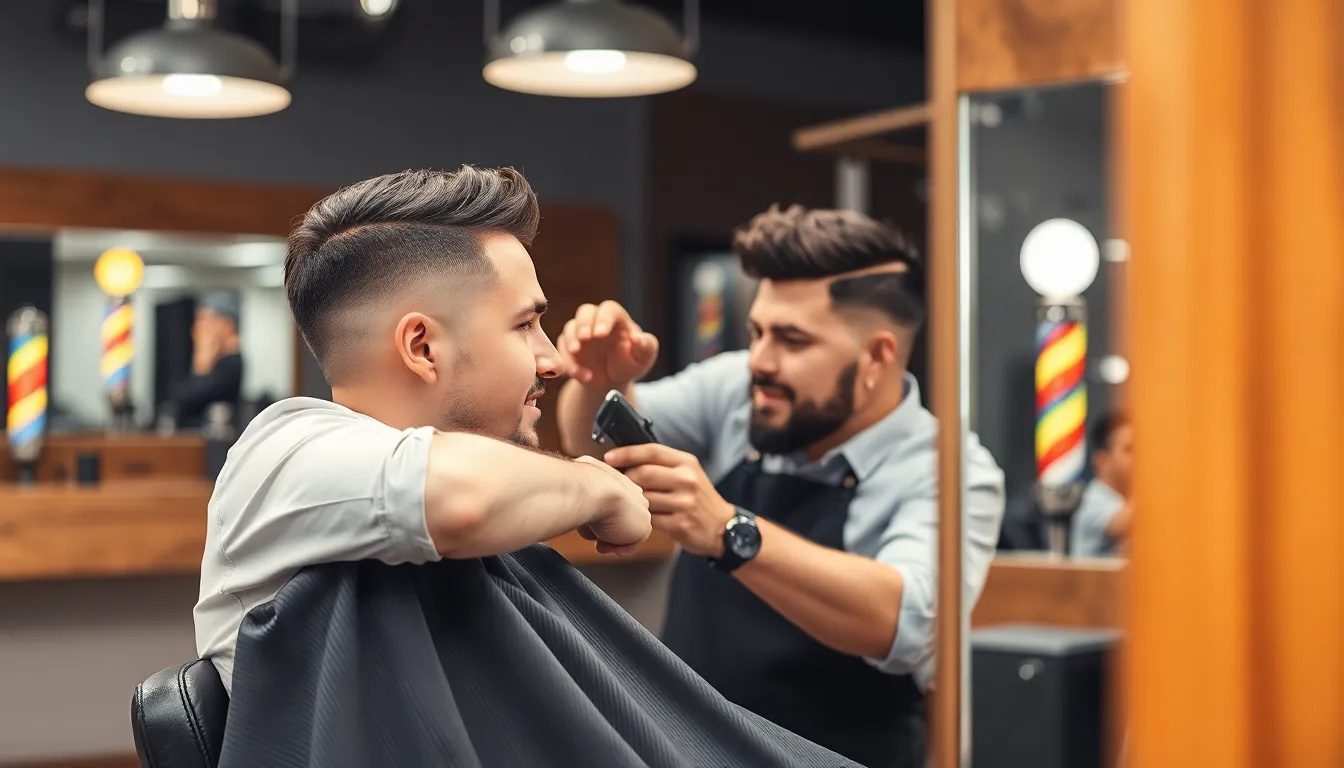
Finding the right barber transforms your blowout taper from a simple haircut into a precision style statement that complements your lifestyle.
Research and Reviews
Start by searching for barbershops in your area that specialize in modern fade techniques and contemporary styling. Read Google Reviews and Yelp ratings to identify barbers with consistently high scores, particularly focusing on comments about fade work and styling expertise. Check social media platforms like Instagram and Facebook for customer feedback, paying attention to before-and-after photos that showcase blowout taper transformations.
Ask friends, coworkers, and family members for personal recommendations, especially those sporting similar haircuts or hair textures. Professional stylists often maintain waiting lists of 2-3 weeks, which typically indicates high demand and quality service. Look for barbershops that have been established for at least 3-5 years, as experience often translates to better technical skills and customer service.
Verify that your chosen barber stays updated with current trends by checking their continuing education credentials or recent workshop attendance. Many top-tier professionals attend monthly training sessions to refine their create and learn new techniques.
Portfolio Assessment
Examine the barber’s Instagram feed or website portfolio for at least 20-30 recent blowout taper examples across different hair types and textures. Quality portfolios showcase clean fade transitions, proper volume distribution, and consistent finishing techniques that demonstrate technical proficiency. Look for diversity in their work, including variations on high, medium, and low taper styles that prove their versatility.
Pay attention to the photography quality and lighting in their portfolio images, as professional presentation often reflects attention to detail in their actual work. Notice whether they show multiple angles of each cut, including side profiles and back views that reveal fade precision and overall shape consistency.
Check for client testimonials or tagged photos from satisfied customers, which provide authentic feedback about their experience and results. Recent work within the past 3-6 months indicates active practice and current skill maintenance.
Consultation Questions to Ask
Begin your consultation by asking about their experience with blowout tapers specifically, including how many they perform weekly and their preferred techniques for different hair textures. Inquire about their approach to customizing the cut based on your face shape, hair growth patterns, and daily styling routine to ensure personalized results.
Ask to see examples of their work on hair similar to yours, including texture, thickness, and growth patterns that might affect the final outcome. Discuss maintenance requirements and realistic expectations for styling time, product needs, and touch-up frequency to avoid disappointment.
Request information about their preferred tools and products, including blow dryer types, styling products, and maintenance recommendations for home care. Professional barbers should provide detailed aftercare instructions and be willing to demonstrate basic styling techniques during your visit.
Confirm their booking policies, cancellation procedures, and typical appointment duration to ensure the service fits your schedule and budget expectations.
Customize Your Blowout Taper with Creative Variations

We’ve explored the fundamentals of achieving the perfect blowout taper, and now it’s time to make this versatile cut uniquely yours. Personalizing your blowout taper opens endless possibilities for self-expression while maintaining the style’s professional appeal.
Adding Hair Designs
Line work transforms your standard blowout taper into a personalized masterpiece that showcases artistic flair. Professional barbers can incorporate geometric patterns, curved lines, or subtle etchings into the tapered sections without compromising the overall style’s clean appearance. Sharp razor lines along the temple area create striking visual interest while maintaining workplace appropriateness.
Zigzag patterns add ever-changing movement to the fade transition zones, creating texture that catches light beautifully. These designs work particularly well on darker hair colors where the contrast between shaved and longer sections creates maximum impact. Popular design placements include the sideburns, nape area, and around the ears.
Star or tribal motifs can be etched into the shortest sections of your taper fade, offering subtle personality without overwhelming the blowout’s volume on top. We recommend starting with simple designs during your first attempt, as intricate patterns require more frequent touch ups every 1-2 weeks to maintain their crisp appearance.
Color Enhancement Options
Highlight placement strategically enhances the blowout taper’s natural volume while creating dimensional depth throughout the style. Blonde or caramel highlights applied to the longer top sections emphasize the contrast between the voluminous crown and tapered sides. Professional colorists often use foiling techniques to achieve precise placement that complements the fade’s gradient.
Subtle lowlights in chocolate or ash tones add sophistication to lighter hair colors while maintaining the blowout taper’s professional versatility. These darker accents work particularly well when placed underneath the top layer, creating depth that becomes visible as hair moves naturally throughout the day.
Color melting techniques blend multiple shades seamlessly from the longest sections to the fade line, creating an ombre effect that follows the taper’s natural progression. This approach works exceptionally well with warm tones like copper, bronze, and golden brown that enhance the style’s modern appeal.
Temporary color options including washable chalk, spray colors, or semi-permanent dyes allow for experimental looks without long-term commitment. These products work best on lighter hair colors and can be applied specifically to the voluminous top section for special occasions or events.
Texture Play Techniques
Layering modifications within the blowout section create varied lengths that enhance natural movement and reduce styling time during daily routines. Strategic layering techniques include point cutting for softer edges, razor cutting for increased texture, and slide cutting for seamless blending between different hair lengths.
Curl enhancement methods maximize natural wave patterns in the longer sections while maintaining the taper’s clean lines. Professional stylists use diffusing techniques, curl creams, and scrunching methods to define existing texture without adding weight that could flatten the blowout’s signature volume.
Straightening contrasts create striking visual differences between sleek top sections and textured fade areas. This technique works particularly well on naturally curly or wavy hair, where temporary straightening of the crown area emphasizes the style’s versatility and modern edge.
Twist and braid elements incorporated into longer top sections add textural interest while maintaining the blowout taper’s overall shape. Small accent braids along the hairline or twisted sections within the voluminous area create focal points that enhance the style’s creative appeal without requiring daily maintenance.
Budget for Your Blowout Taper Investment
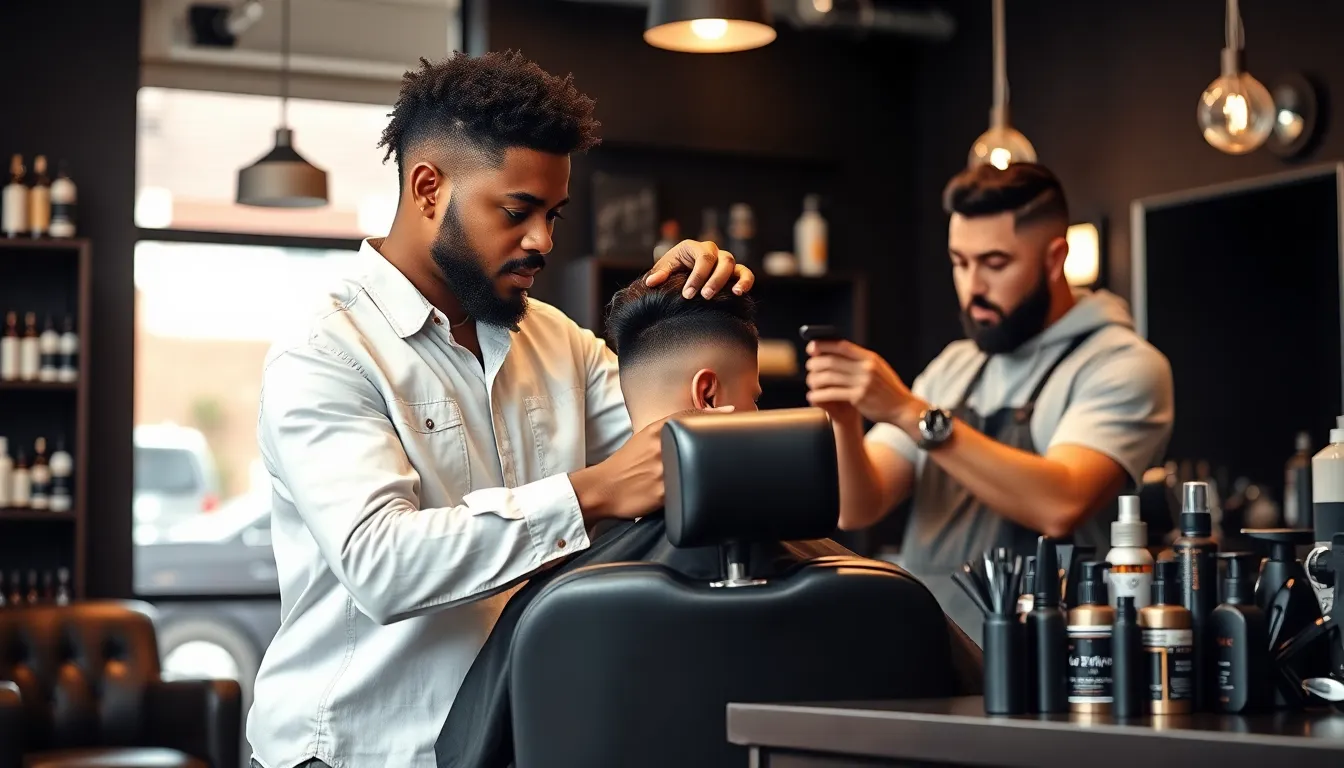
Planning your blowout taper budget helps ensure you get quality results without overspending. We’ll break down the typical costs and share strategies to maximize your investment.
Average Cost Breakdown
Initial blowout taper cuts typically range from $25 to $85 depending on your location and barber expertise. Entry-level barbershops in smaller cities often charge between $25-40, while premium salons in metropolitan areas command $60-85 per visit.
Specialized blowout taper experts usually charge 20-30% more than standard haircut prices due to their advanced techniques and equipment. These professionals invest in high-end blow dryers, quality styling products, and ongoing education to perfect their create.
Geographic location significantly impacts pricing, with costs varying by region:
| Location Type | Price Range |
|---|---|
| Small Cities | $25-40 |
| Suburban Areas | $35-55 |
| Major Metropolitan | $50-85 |
| Premium Salons | $65-100 |
Additional services can increase your total investment. Beard trimming adds $10-20, while hair washing and conditioning treatments range from $5-15 extra per visit.
Maintenance Expenses
Monthly maintenance costs typically total $75-200 based on your cutting schedule and product needs. Most clients require touch-ups every 3-4 weeks to maintain the blowout taper’s sharp appearance.
Quality styling products represent ongoing investments in your haircut’s longevity. Volumizing mousse costs $8-25 per bottle and lasts 2-3 months, while heat protectant sprays range from $10-30 and provide similar duration.
Professional-grade blow dryers enhance your at-home styling with prices spanning $50-200. These tools help recreate the salon finish and reduce styling time by 30-40% compared to basic dryers.
Deep conditioning treatments every 4-6 weeks support hair health and blowout performance. Salon treatments cost $20-50, while at-home alternatives range from $8-20 per application.
Money-Saving Tips
Book appointments during off-peak hours to secure discounts of 10-20% at many barbershops. Tuesday through Thursday mornings often offer the best rates and more personalized attention.
Package deals reduce per-cut costs when you commit to multiple visits. Many establishments offer 20-25% savings when you purchase 4-6 cuts in advance.
Student and military discounts provide automatic savings ranging from 10-15% off regular prices. Always ask about available discounts before booking your appointment.
Learn basic maintenance techniques to extend time between professional visits. Mastering proper blow-drying methods can stretch your cuts an extra 1-2 weeks while maintaining style integrity.
Generic styling products deliver similar results at 40-60% less cost than salon brands. Compare ingredient lists and read reviews to find effective alternatives that work with your hair type.
Loyalty programs reward consistent clients with free cuts after 8-10 visits or percentage discounts on services. Track your visits to maximize these benefits over time.
Conclusion
We’ve covered everything you need to know about mastering the blowout taper – from choosing the right variation for your face shape to budgeting for long-term maintenance. This versatile haircut offers the perfect balance of professionalism and style that works across different settings and hair textures.
Remember that investing in a skilled barber and quality products will pay dividends in achieving that salon-fresh look. With proper maintenance techniques and smart budgeting strategies we’ve shared you’ll keep your blowout taper looking sharp without very costly.
The blowout taper isn’t just a trend – it’s a timeless style that adapts to your lifestyle and personal preferences. Whether you’re heading to the boardroom or weekend hangouts this haircut delivers the confidence boost that comes with looking your absolute best.
Frequently Asked Questions
What is a blowout taper haircut?
A blowout taper is a modern men’s haircut that combines the precision of a taper fade with the volume of a blowout. It features clean, tapered sides that gradually blend into longer, voluminous hair on top. This versatile style works well for both professional and casual settings, offering a polished appearance that’s gained popularity among celebrities and social media users.
How often should I get a blowout taper touch-up?
You should schedule touch-ups for your blowout taper every 3-4 weeks to maintain its fresh appearance. The taper fade grows out quickly, and regular maintenance ensures the clean lines and proportions stay intact. Some men with faster hair growth may need touch-ups every 2-3 weeks, while others can stretch it to 4-5 weeks.
What face shapes work best with a blowout taper?
The blowout taper is highly versatile and can be customized for various face shapes. Round faces benefit from added height on top, while square faces can soften angular features with textured styling. Oval faces work well with most variations, and longer faces can opt for more volume on the sides to create better proportions.
How much does a blowout taper cost?
The cost of a blowout taper varies by location and barber expertise, typically ranging from $25-75 for the initial cut. Maintenance appointments cost $20-50 every 3-4 weeks. Urban areas and experienced barbers generally charge more. Additional services like beard trimming or styling products can increase the total cost by $10-30 per visit.
What products do I need to style a blowout taper?
Essential styling products include a quality blow dryer, round brush, heat protectant spray, and styling cream or pomade. Volumizing mousse helps create the signature blowout effect, while light-hold hairspray maintains the style throughout the day. Generic brands can provide similar results to expensive products, helping you save money on maintenance.
Can I style a blowout taper at home?
Yes, you can style a blowout taper at home with the right tools and technique. Start with damp hair, apply heat protectant and volumizing products, then use a blow dryer with a round brush to create volume and shape. Practice makes perfect, and learning basic styling techniques can help extend time between professional appointments.
What’s the difference between a blowout taper and regular taper fade?
The main difference is the styling on top. A regular taper fade focuses on the gradual length transition from sides to top, while a blowout taper specifically styles the longer hair on top with volume and texture. The blowout taper requires more styling time and products but creates a more dynamic, textured appearance.
How do I find the right barber for a blowout taper?
Research local barbershops and review their portfolios, especially looking for blowout taper examples. Check online reviews and social media presence. During consultations, ask about their experience with the style, discuss your face shape and lifestyle, and ensure they understand your desired look. Don’t hesitate to ask questions about maintenance and styling tips.











